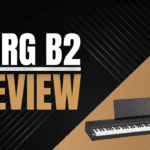As an electronic musician and synthesizer enthusiast, I’m always on the lookout for new instruments that can inspire creativity and bring fresh sounds to my productions. When Korg released the Minilogue back in 2016, it immediately caught my attention as an affordable and versatile analog polyphonic synthesizer.
I was eager to get my hands on one to see if it lived up to the hype. After extensive use over several months, I’m ready to share my in-depth review of the Minilogue’s design, sound, features, and usability.
First Impressions

Upon unboxing the Minilogue, I was struck by its stylish aesthetic. The metal front panel and wooden back panel give it a very retro, almost vintage vibe. Yet the angled control panel and unique pitch/mod touch strip bring a modern edge.
Weighing in at only 5lbs, the Minilogue has a surprisingly sturdy build quality with knobs and switches that feel solid and durable.
The Minilogue features a 4-octave keyboard with slim, velocity-sensitive keys. As someone with larger hands, I found the narrow keys to be a bit cramped for playing complex chords and leads.
However, the keys are responsive and the reduced size helps keep the Minilogue’s footprint compact.
Oscillators: Analog Sound with Digital Flexibility

At its heart, the Minilogue houses two analog voltage-controlled oscillators (VCOs) per voice. Having dual VCOs allows you to create sounds with more warmth, depth, and movement compared to single oscillator synths. The Minilogue’s VCOs can generate sawtooth, triangle, and variable pulse/square waves.
What gives the Minilogue extra sonic versatility is the additional digital Multi-Engine oscillator. This acts as a third oscillator that can produce noise as well as a selection of digital waveforms. Having this hybrid analog/digital design really expands the Minilogue’s range of tones beyond traditional analog synths.
I especially like the User slot in the Multi-Engine section. It allows you to load custom user-created waveforms, opening up endless sound design possibilities. Korg even provides a software development kit (SDK) to design your own oscillators!
Filter: Warm, Responsive, and Aggressive When Pushed
The Minilogue’s filter is a 2-pole low-pass filter modeled after classic analog synths. I was pleased to find that it retained warmth and bass even at high resonance settings, which can be an issue on some synths. The filter has a very musical quality, adding movement and animation to held notes.
Pushing up the filter’s drive knob adds some satisfying crunch and grittiness to the sound. It brings an almost overdriven quality when maxed out.
I do wish the filter cutoff had a dedicated knob rather than sharing duties with the pitch EG amount knob. But the filter cutoff is still easy to control via the touch strip.
Envelopes and LFOs: Fast, Punchy Modulation

Having quick, snappy modulation shapes is key for analog synths, and the Minilogue delivers on this front. Its amp and filter envelopes have attack times down to just 10 milliseconds, allowing for percussive sounds with an immediate punch. The LFOs are also speedy, with a rate range up to 50 Hz for audio rate modulation effects.
Between the LFOs and envelopes, it’s easy to get animated sounds using filter cutoff or oscillator pitch as a destination. I especially like the pitch EG for creating laser zap effects and crazy pitch sweeps. The LFOs sync to the tempo which is great for rhythmic modulation.
Effects: Quality Reverbs, Delays, and Modulation
While the Minilogue’s core sound engine is analog, it features a nice selection of digital effects to add space, motion, and interest. The reverb and delay effects are surprisingly high quality for a synth in this price range. I often find myself adding just a touch of room reverb to fatten up pads and leads.
The modulation effects like chorus, flanger, and phaser all have a very lush, rich character to them. They remind me of classic rackmount effects units. I was able to get some very complex evolving sounds by combining the modulation effects with the LFOs modulating filter cutoff.
Sequencer: Simple Yet Powerful
One of my favourite features of the Minilogue is its built-in 16-step sequencer. While it looks rather basic at first glance, the sequencer is capable of creating intricate patterns and sequences. Each of the 16 steps can contain up to 4 notes, allowing you to program chords as well as melodies.
The motion sequencing feature also lets you record knob movements per step. By modulating parameters like filter cutoff or LFO depth, I could get sequenced filter sweeps, dreamy pitch vibrato, and more. This elevated the sequencer beyond just programming notes.
I do wish it had a way to transpose sequences using the keyboard like the Monologue’s key trig mode. But overall it’s a versatile sequencer that I’ve used to make full tracks.
Voice Modes: Unison, Duo, and Chord
One unique aspect of the Minilogue is its Voice modes section. This lets you stack and layer the 4 voices for thicker, richer sounds. The Unison mode stacks all 4 voices to create a massive monophonic synth lead. Duo mode splits the 4 voices into two detuned pairs for a wide stereo chorus effect.
My personal favourite is the Chord mode, which takes a single key press and turns it into an automatic chord. Major, minor, suspended, and diminished chords are built right in. This makes the Minilogue an ideal pad and accompaniment machine.
The Voice modes really expand the Minilogue’s capabilities beyond a standard polyphonic synth.
Here is an additional section on the Korg Minilogue’s connectivity options:
Connectivity: Flexible I/O for Studio and Live Applications

The Korg Minilogue provides a solid selection of input and output connections given its compact size. For audio outputs, there are stereo 1/4″ outputs as well as a headphone jack with dedicated volume control. The Minilogue can be connected to a mixer or audio interface using standard instrument cables.
MIDI connectivity includes MIDI In and Out ports on 5-pin DIN connectors. The MIDI implementation is quite thorough, allowing for control of parameters like oscillator pitch and filter cutoff. Syncing LFOs and sequencer tempo to external MIDI clock is a breeze.
One feature I really appreciate is the audio input. This allows you to route external audio through the Minilogue’s filter and effects. You can process vocals, drums, or entire mixes using the synth engine.
For syncing multiple Minilogues together, there is a Sync In/Out jack using the standard analog pulse waveform. I’ve enjoyed connecting 2-3 Minilogues together to get huge layered unison sounds using the sync connections.
My only complaint regarding connectivity is the lack of USB MIDI or any way to interface directly with a computer. To control or sequence the Minilogue via USB, you need to use the included MIDI adapter. Not a dealbreaker but native USB-MIDI would be more convenient.
Overall the Minilogue provides the essential I/O options needed for integration into any studio or live setup. The audio input flexibility adds an extra dimension to its usefulness as a sound design tool. Between the MIDI and sync jacks, it plays nice with external gear and instruments. The Minilogue nails connectivity for a synth in its class.
Overall Impressions
After extensive use in my studio for multiple productions, I can confidently say that the Korg Minilogue is an outstanding synth for its price point. The combination of analog and digital oscillators provides a diverse palette of sounds, from deep booming basses to crystalline pads.
The filter and effects give warmth and motion that brings sounds to life. And the sequencer, chord modes, and touch strip make the Minilogue fun for live playing.
Are there things I’d change about the Minilogue? A few minor details like adding an arpeggiator, aftertouch, and an extra LFO. But considering its affordable price, Korg included an amazing amount of features and sound design possibilities.
The Minilogue has become my go-to synth for everything from funky bass lines to cinematic soundscapes. It’s equally at home in a studio or live rig.
For anyone looking to dip their toes into the world of analog synthesis without breaking the bank, I can’t recommend the Korg Minilogue enough. It’s got that vintage analog sound but with a modern workflow.
If you’re an experienced synth user, the Minilogue will likely still impress you with its rich voice architecture. This synth has earned a permanent spot in my studio setup.
The Good
- Warm, rich analog sound with digital flexibility
- Versatile oscillators with custom user waveform loading
- Snappy filter with overdrive for aggressive tones
- Quality effects like chorus, reverb, and delay
- Sequencer allows chord and motion sequencing
- Cool voice modes like unison, duo, and chord
- Extremely affordable price for an analog polyphonic synth
The Bad
- Slim mini-keys not ideal for players with large hands
- Filter cutoff not controlled by a dedicated knob
- No arpeggiator or aftertouch
The Bottom Line
With its fusion of analog and digital oscillators, hands-on control, and powerful sequencer, the Korg Minilogue offers tremendous value for any producer, composer, or performer looking for vintage analog sound in a modern portable package.





